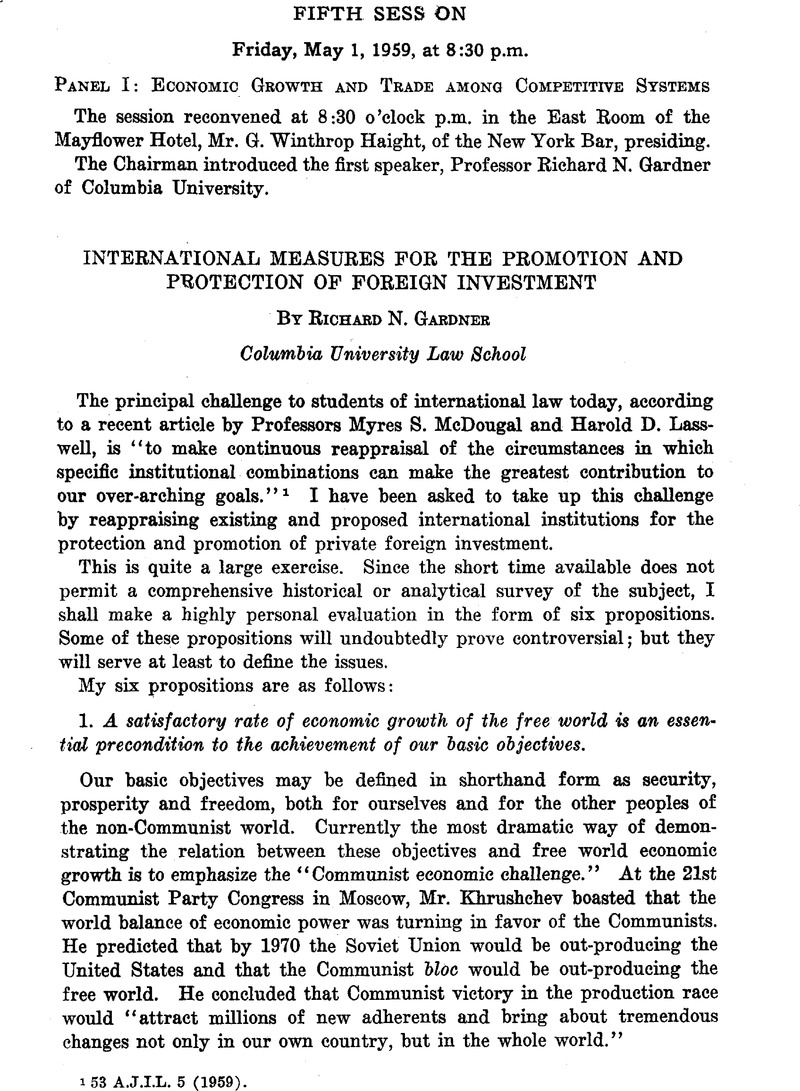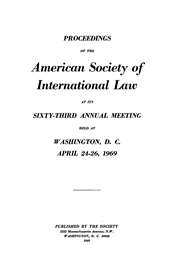No CrossRef data available.
Article contents
International Measures for the Promotion and Protection of Foreign Investment
Published online by Cambridge University Press: 27 February 2017
Abstract

- Type
- Fifth Session
- Information
- Proceedings of the American Society of International Law at its annual meeting (1921-1969) , Volume 53 , 1959 , pp. 255 - 266
- Copyright
- Copyright © American Society of International Law 1959
References
1 53 A.J.I.L. 5 (1959).
2 For more detailed argument in support of this and the following two propositions, see Richard N. Gardner, New Directions in U. S. Foreign Economic Policy (Foreign Policy Association Headline Series, Booklet No. 133 (1959)).
3 The figures eited above are the author's estimates based on analysis of the U. S. Department of Commerce periodical, Survey of Current Business, and United Nations, Department of Economic Affairs, The International Flow of Private Capital 1956–58 (Doc. E/3249, May, 1958). The lack of data on capital movements in many countries and the incomparability of much of the data that is available make it necessary to emphasize that the figures given above are only rough estimates.
4 United Nations, Information Concerning International Economic Assistance for the Less Developed Countries, Report by the Secretary General (Doc. E/3074, Sept. 24, 1957).
5 The most important efforts have been led by groups under the direction of Hermann Abs of Germany and Sir Hartley Shawcross of the United Kingdom. The summary which follows is based on recent drafts of a “Convention on Investments Abroad” which appears to be the joint work of these groups. For more details on the Abs and Shawcross efforts, see Arthur S. Miller, “Protection of Private Foreign Investment by Multilateral Convention,” 53 A.J.I.L. 371 (1959), and Michael Brandon, “An International Investment Code: Current Plans,” Journal of Business Law (January, 1959).
6 The Preamble of the “Convention on Investments Abroad” (April draft) contains language suggesting that the Convention is a “restatement of principles.” In several important respects it is clearly a good deal more than that. International law in its present state of development, for example, does not require that compensation for lawfully expropriated property be made in transferable form. Reference in the Comment to the Convention (p. 11) to the S. S. Wimbledon (1923), P. C. I. J., Series A., No. 1, is not in point. That case involved a distinctly different question—the currency in which to pay damages for an international wrong. It is one thing to say that Germany must pay in francs for wrongful refusal of passage through the Kiel Canal which causes damages to a French company; it is quite another to say that Germany must pay francs upon taking the property of a French company or citizen located within German territory, particularly where such property may be the product of reinvested mark earnings and where the corporation or person is a permanent resident of Germany and has the opportunity to reinvest marks within the country.
This is not to say that transferability should not be required as a matter of policy, but only that different issues are at stake here and should be examined separately from the issues involved in cases of the Wimbledon type. It should be recalled also that restrictions on the transfer of compensation for expropriated property can be justified under Arts. VI and XIV of the Articles of Agreement of the International Monetary Fund. As the following paragraph in the text points out, such restrictions in circumstances of exchange stringency are specifically permitted even in those U. S. bilateral treaties most favorable to investors.
7 T. I. A. S., No. 3593, Art. V(4).
8 Seymour J. Rubin, Private Foreign Investment: Legal and Economic Realities 17, 77 (1956).
9 Art. XII (4).
10 T. I. A. S., No. 2863, Art. XII(3).
11 Even between countries which share as much of a consensus as the United States and Britain, premature attempts to draft detailed principles of international economic conduct have proved self-defeating. See Richard N. Gardner, Sterling-Dollar Diplomacy (1956), especially Parts 3 and 4.
12 This point is well developed in Bubin, op. cit. note 8 above.
13 International Development Advisory Board, A New Emphasis on Economic Development Abroad, A Report to the President (1957), p. 13.
14 The proposals in this paragraph would, of course, require amendments to the Articles of Agreement of the I. M. F., I. B. B. D., and I. F. C.


